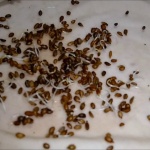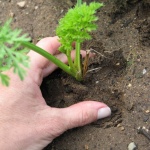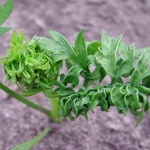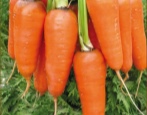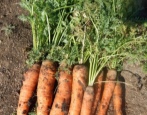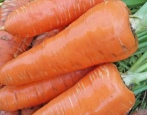
- Authors: Zhidkova N.I., Kvasnikov B.V., Belik T.A.
- Year of approval: 1969
- Appointment: for fresh consumption, for canning, for making juice
- Leaf rosette shape: semi-standing
- Weight, g: up to 170
- The form : oblong cylindrical with a slightly blunt tip
- Taste qualities: excellent
- Ripening terms: mid-season
- Growing regions: North, North-West, Central, Volgo-Vyatka, TsChO, Middle Volga, Ural, West Siberian, East Siberian, Far East, Nizhnevolzhsky
- Length, cm: 17
Carrots are always in demand among summer residents and are included in the standard set of things that everyone should grow on their site. Variety Vitamin 6 is ideal for growing on any soil. The culture is unpretentious and has high yield rates. It is appreciated not only for the size of the fruit, but also for their wonderful sweet taste.
Breeding history
Carrot Vitamin 6 was developed over 50 years ago. The authors were N.I. Zhidkova, T.A. Belik and B.V. Kvasnikov. All work was carried out at the Research Institute of Vegetable Economy. For the parental pair, the varieties Nantskaya and Berlicium were selected. In 1969, the variety was allowed for mass use.
Description of the variety
Carrot Vitamin 6 is a varietal crop that has a number of advantages and disadvantages.
The advantages of summer residents include unpretentiousness in cultivation and weather conditions. The variety has good yields. Root crops have excellent keeping quality. With proper care of the crop during cultivation, the fruits do not crack. There is a high content of fructose and beta-carotene in carrots, as well as a wonderful sweet taste.
Among the disadvantages can be noted a weak immunity to fungal diseases. Only fresh seed should be used for cultivation. Seeds that are two years old may not sprout.
Characteristics of the appearance of the plant and root crops
The rosette of the carrots is half-standing. It forms from 8 to 12 dissected green leaves. The height of the tops is 15 to 20 cm.
The root crop is oblong, cylindrical in shape. The tip is slightly blunt and rounded. The length of the carrot is 15-17 cm, and the diameter is 4-5 cm.The weight varies from 65 to 170 g.
The color of the bark is orange or red-orange. The base at the point of connection with the socket has a dark green color. The surface of the root crop is smooth, with shallow, shallow eyes.
The core is small, round and star-shaped. The pulp is juicy, tender, dense and homogeneous.
Purpose and taste of tubers
The culture belongs to universal varieties, so it can be eaten fresh, used for making salads or for hot dishes, juices or mashed potatoes. And also preserve, freeze and store in the cellar all winter.
Carrots have a sweet taste due to the fact that they contain up to 11% fructose, which is approximately 15-20 mg per 100 g. Compared with other varieties, the fructose content does not exceed 5-6%.
The beta-carotene in Vitamin 6 is also sufficient. Per 100 g, the indicators are 7-10% or 17-20 mg. In other varieties, the indicators will be 9 mg, which is approximately 2-3%.
In addition, the culture contains a large amount of vitamins A, B, C, E, as well as trace elements.
There are 23.5-24 kcal per 100 g of vegetable.
Maturation
Vitamin 6 is ranked among mid-season varieties. The period from germination to harvest is 75-100 days.
Yield
Carrots are distinguished by high yield rates. Subject to all agrotechnical standards, 6-8 kg can be removed from 1 m2. The average indicator for all regions is 3.5-4 kg per 1 m2.
Growing regions
Favorable regions for growing Vitamin 6 carrots are:
- Northern;
- Ural;
- Central;
- Northwestern;
- Nizhnevolzhsky;
- Volgo-Vyatsky;
- TsCHO;
- West Siberian;
- Far Eastern.
It is not recommended to grow the crop in the North Caucasus region.
Growing and care
All carrot seed is sold either in pellets or in belts. This makes the sowing process easier. In the belts, the order and the distance between the seeds are immediately respected. It is worth remembering that increased watering is required for pellet seeds.
If the seeds are harvested on their own, then they must first be processed. The seed should be sorted out and then soaked in cool water for an hour. During this time, all empty seeds will float in, and quality seeds will gradually sink to the bottom.
All selected seeds must be processed in a weak solution of potassium permanganate or a special solution of "Fitosporin". Soak for 40-60 minutes.
Further, the change is worth germinating. For this, use a damp cloth. After the first sprouting, all the material is treated with the Epin growth stimulator.
Some gardeners plant carrots immediately after frost, when the temperature rises to + 8 ° C. The place is chosen sunny, and the soil is pre-dug up with organic matter in the form of compost or manure.
The distance between the rows should be at least 15 cm, and the seeding pattern should be 20-30 cm x 5-8 cm.
Subsequent agronomic care should include the following points.
- Watering. Irrigation should be done 1-2 times a week. In severe drought with a complete lack of precipitation, watering increases up to 3-4 times. By the middle of the vegetative period, the procedure is reduced to 1 time, while the volume of the applied liquid increases.
- Loosening and thinning. The soil should be loosened after each watering, while it is worth removing all the weeds that are in the garden. And thinning begins from the moment when the vegetable grows 2-4 pairs of leaves. Weak seedlings are removed.
- Carrots are fed several times per season. For this, urea, potassium, phosphorus are suitable. At the time of formation, root crops are fed with boron and manganese. Nitrogen is most commonly used at the beginning of the growing season. In total, fertilizers are applied 3-4 times.
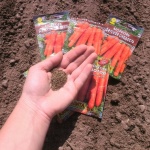
Carrots are one of the most unpretentious crops in terms of growing conditions; they can endure a short drought and a short cold snap. However, to get tasty and large root crops, you should adhere to the basic rules for planting carrots.

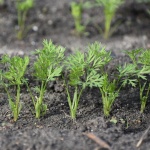
Soil requirements
For growing carrots Vitamin 6, mineral and peat soils are best suited. The acidity is neutral. Drained and loose soil is also suitable.
Disease and pest resistance
Since the variety has weak immunity, most often it is subject to the following diseases.
- Dry rot. At first it appears on the tops in the form of gray-brown spots, and then gradually passes to root crops. They start to rot. For prevention, phosphorus-potassium fertilizers are used.
- Rhizoctonia also causes rotting of vegetables. It appears as small lead spots on the skin. Bushes that have been affected by this ailment should be treated with a solution of copper sulfate.
- Bacteriosis, or wet rot.Appears on the lower leaves in the form of yellow spots, gradually the coverage increases, and the plates begin to darken and dry out. Over time, small wet areas of a dark color appear on the root crop, and then an unpleasant, pungent smell of rot. For prophylaxis, it is sprayed with the preparation "HOM".

Carrots grow in almost any garden. There is an opinion that this culture is very resistant to all kinds of diseases and pests, but this is not the case. Without proper care, carrots become susceptible to all kinds of infections and are affected by harmful insects.


